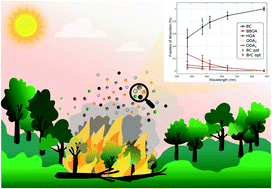Linking the chemical composition and optical properties of biomass burning aerosols in Amazonia†
Abstract
Biomass burning emissions in Amazonia change the atmospheric composition and aerosol properties during the dry season. We investigated fine-mode aerosol chemical composition and optical properties with an intensive field experiment in the dry-to-wet season transition in 2018 in Southwestern Amazonia. Aerosol composition and physical properties were measured using ACSMs, aethalometers, nephelometers, SMPSs, and CPCs. PM1 mass concentrations showed a mean value of 12.4 ± 10.1 μg m−3. Organic matter was the major constituent of PM1, contributing more than 75%, whereas black carbon (BC) contributed ∼15%, and inorganics were less than 10%. The organic fraction of PM1 was apportioned by positive-matrix factorization (PMF), resolving 4 organic aerosol (OA) factors: two oxygenated OAs (OOA-1 and OOA-2), one hydrocarbon-like (HOA), and one biomass burning OA (BBOA). A low single scattering albedo (637 nm) of 0.77 ± 0.08 was observed, suggesting a significant absorption material. BC and brown carbon (BrC) contributions to the absorption coefficient (470 nm) were retrieved, and BrC corresponded, on average, to 20% of total absorption. The mass scattering (MSE) and absorption efficiencies (MAE) of PM1 particles were determined by multilinear regression (MLR), using the PMF factors as predictor variables. Overall, organic aerosols showed significant light absorption in the UV-vis wavelength range and strong spectral dependence indicating the presence of organic species that act as BrC, predominantly associated with biomass burning OAs. Our results emphasize the need for a better understanding of links between aerosol composition and optical properties, including the absorption spectra of BrC in the Amazon.

- This article is part of the themed collections: ES: Atmospheres Hot Papers and ENQA - 20th Brazilian Meeting on Analytical Chemistry


 Please wait while we load your content...
Please wait while we load your content...